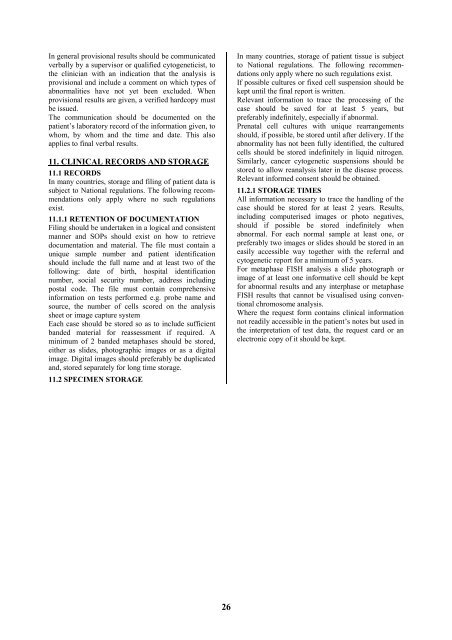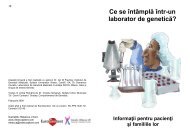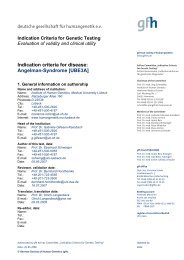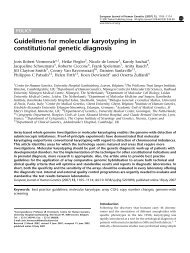Cytogenetic Guidelines and Quality Assurance - EuroGentest
Cytogenetic Guidelines and Quality Assurance - EuroGentest
Cytogenetic Guidelines and Quality Assurance - EuroGentest
Create successful ePaper yourself
Turn your PDF publications into a flip-book with our unique Google optimized e-Paper software.
In general provisional results should be communicated<br />
verbally by a supervisor or qualified cytogeneticist, to<br />
the clinician with an indication that the analysis is<br />
provisional <strong>and</strong> include a comment on which types of<br />
abnormalities have not yet been excluded. When<br />
provisional results are given, a verified hardcopy must<br />
be issued.<br />
The communication should be documented on the<br />
patient’s laboratory record of the information given, to<br />
whom, by whom <strong>and</strong> the time <strong>and</strong> date. This also<br />
applies to final verbal results.<br />
11. CLINICAL RECORDS AND STORAGE<br />
11.1 RECORDS<br />
In many countries, storage <strong>and</strong> filing of patient data is<br />
subject to National regulations. The following recommendations<br />
only apply where no such regulations<br />
exist.<br />
11.1.1 RETENTION OF DOCUMENTATION<br />
Filing should be undertaken in a logical <strong>and</strong> consistent<br />
manner <strong>and</strong> SOPs should exist on how to retrieve<br />
documentation <strong>and</strong> material. The file must contain a<br />
unique sample number <strong>and</strong> patient identification<br />
should include the full name <strong>and</strong> at least two of the<br />
following: date of birth, hospital identification<br />
number, social security number, address including<br />
postal code. The file must contain comprehensive<br />
information on tests performed e.g. probe name <strong>and</strong><br />
source, the number of cells scored on the analysis<br />
sheet or image capture system<br />
Each case should be stored so as to include sufficient<br />
b<strong>and</strong>ed material for reassessment if required. A<br />
minimum of 2 b<strong>and</strong>ed metaphases should be stored,<br />
either as slides, photographic images or as a digital<br />
image. Digital images should preferably be duplicated<br />
<strong>and</strong>, stored separately for long time storage.<br />
11.2 SPECIMEN STORAGE<br />
26<br />
In many countries, storage of patient tissue is subject<br />
to National regulations. The following recommendations<br />
only apply where no such regulations exist.<br />
If possible cultures or fixed cell suspension should be<br />
kept until the final report is written.<br />
Relevant information to trace the processing of the<br />
case should be saved for at least 5 years, but<br />
preferably indefinitely, especially if abnormal.<br />
Prenatal cell cultures with unique rearrangements<br />
should, if possible, be stored until after delivery. If the<br />
abnormality has not been fully identified, the cultured<br />
cells should be stored indefinitely in liquid nitrogen.<br />
Similarly, cancer cytogenetic suspensions should be<br />
stored to allow reanalysis later in the disease process.<br />
Relevant informed consent should be obtained.<br />
11.2.1 STORAGE TIMES<br />
All information necessary to trace the h<strong>and</strong>ling of the<br />
case should be stored for at least 2 years. Results,<br />
including computerised images or photo negatives,<br />
should if possible be stored indefinitely when<br />
abnormal. For each normal sample at least one, or<br />
preferably two images or slides should be stored in an<br />
easily accessible way together with the referral <strong>and</strong><br />
cytogenetic report for a minimum of 5 years.<br />
For metaphase FISH analysis a slide photograph or<br />
image of at least one informative cell should be kept<br />
for abnormal results <strong>and</strong> any interphase or metaphase<br />
FISH results that cannot be visualised using conventional<br />
chromosome analysis.<br />
Where the request form contains clinical information<br />
not readily accessible in the patient’s notes but used in<br />
the interpretation of test data, the request card or an<br />
electronic copy of it should be kept.















